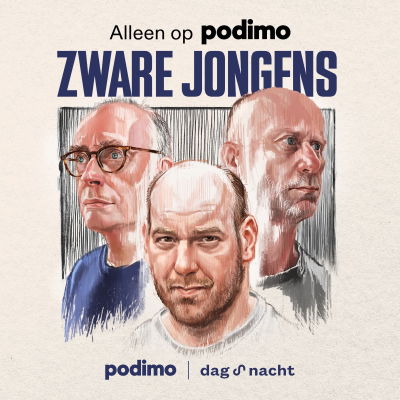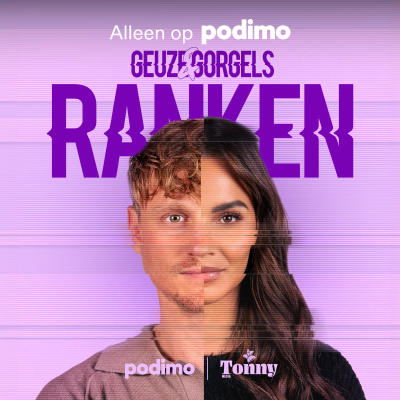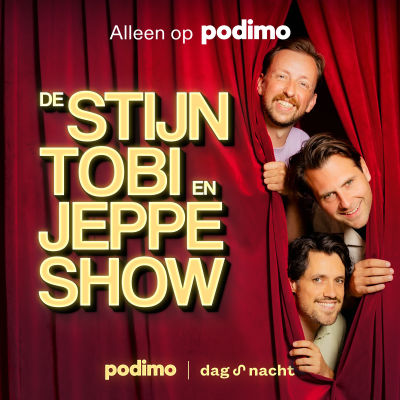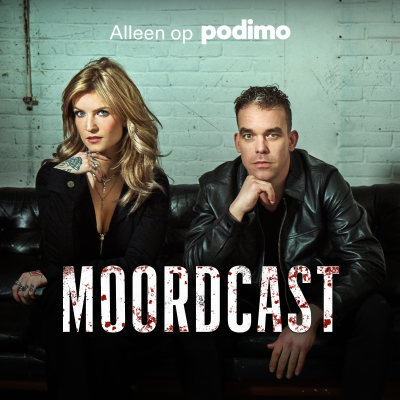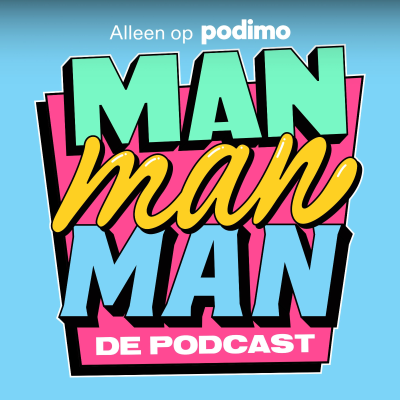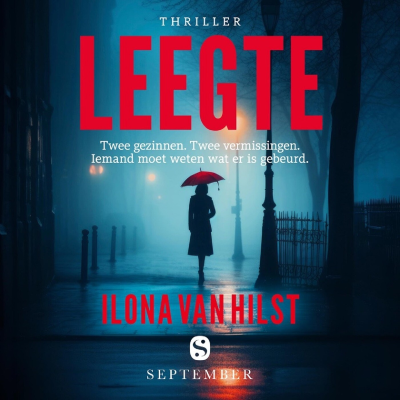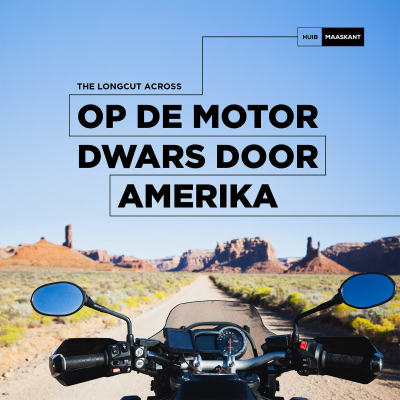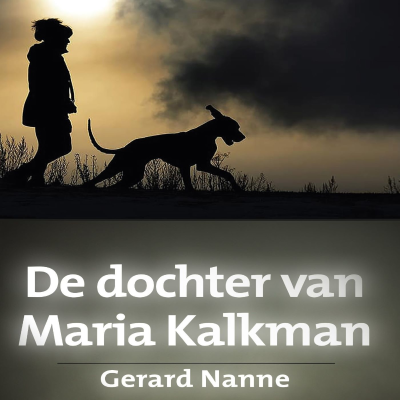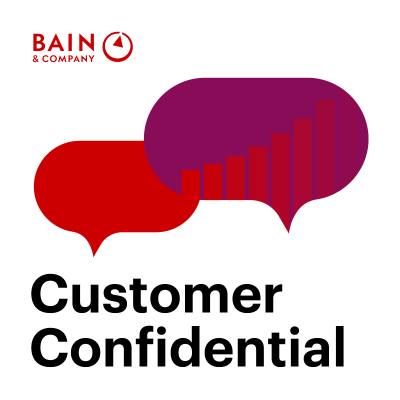
Customer Confidential: Untold Stories of Earned Growth
Engels
Business
Tijdelijke aanbieding
1 maand voor € 1
Daarna € 9,99 / maandElk moment opzegbaar.
- 20 uur luisterboeken / maand
- Podcasts die je alleen op Podimo hoort
- Gratis podcasts
Over Customer Confidential: Untold Stories of Earned Growth
The Customer Confidential Podcast unlocks a world of unparalleled customer and employee loyalty insights. Host Rob Markey, a Net Promoter System pioneer, uses his deep expertise and empathetic approach to challenge conventional wisdom, peel back layers of typical advice, and expose the real stories of industry transformation. Take a deep dive into discussions on CX, customer journey, customer insights, Net Promoter Score, and more. Every episode is a master class in loyalty. Guests include CMOs, CXOs, and heroes of customer-centric transformation, along with thought leaders who inspire them. Exploring organizational structures, operating models, goals, and metrics, Rob and his guests from companies such as Vanguard, American Express, and more bring to light practical marketing, product, customer experience, and technology strategies for earning customer-focused growth. This podcast is your source for untold stories of customer and employee loyalty. Challenging, insightful, and instructive—all in one place. Earned growth starts here.
Alle afleveringen
261 afleveringenEp. 259 | Rachel Bicking: Customers' First Micro-Frustration Makes or Breaks the Next Purchase
Episode 259: How do you prevent first-trip hassles such as a room not being ready at check-in, Wi-Fi outages, or service delays from discouraging first-time customers from returning? Today's guest, Rachel Bicking, EVP of Innovation at Kobie Marketing, says that after a slightly negative first trip, customers are 80% less likely to return. Kobie—a technology platform that builds and runs rewards and loyalty programs—is solving this. They use a "journey atlas" to read social signals, spot subtle first-trip frictions, and then trigger targeted offers or fixes. They model lift and rewards liability so that investment can follow behavior change. Journey maps freeze a tense customer moment. A live atlas shows where small failures block the next purchase and coordinates fixes across channels. Inside the business, spending becomes about precision. Simulators forecast lift, break-even, and profit impact by segment and moment, so finance are able to see trade-offs before money moves. The payoff? Practical programs that grow trips, expand categories, and raise lifetime value. Guest: Rachel Bicking [https://www.linkedin.com/in/rachelbicking], EVP of Innovation, Kobie Marketing Host: Rob Markey [https://www.linkedin.com/in/robmarkey/], Partner, Bain & Company Give Us Feedback. Help us improve the podcast here: https://bit.ly/CCPodcastFeedback [https://bit.ly/CCPodcastFeedback] Time-Stamped Topics: * [00:03] First-trip friction that kills repeat purchases, with examples and fixes * [00:10] Personalization that simplifies the customer experience * [00:12] Emotional Loyalty Scoring, habit, status, and reciprocity * [00:21] Coordinating recovery across store, app, and site for the same customer * [00:23] Using precision to avoid incentivizing the wrong customer base * [00:27] Designing redemptions to expand baskets, categories, and trip frequency * [00:31] Accounting for redemption cost and liability without derailing good decisions * [00:34] Using simulators to forecast lift and break-even before spending a dollar * [00:36] The moment modeling convinces finance to reallocate the budget Time-Stamped Quotes: * 00:05 — "What we're trying to do at scale is identify those moments that matter and those micro-moments that then lead to a negative or positive experience. Because we want to amplify the positives and we want to make sure that we intercept the negative ones." * 00:07 — "I think there's been a broader inclination to say, 'Hey, if it's below a certain amount, people don't care.' And this is where personalization becomes really important. If I get delayed checking into my hotel room and I have to go to the next meeting and I don't have time to put my stuff down, ten minutes matters." * 00:08 — "Data-wise, we're always trying to break down customers' interactions [and] rewards into a series of metadata, into a series of features, so that we can make them more explainable at scale." * 00:13 — "If personalization is done well, the experience from a customer perspective should be very simple. It should be guided. It should be deliberate."
Ep. 258: Charlon McIntosh & Melissa Pint | Accountability is the Product at Frontier: "We Didn't Do Interesting. We Did Effective."
Episode 258: How did two new leaders turn angry customer calls into executive promises to earn customer trust and advocacy? Charlon McIntosh, Chief Customer Operations Officer, and Melissa Pint, Chief Digital Information Officer, both joined Frontier Communications on the same day in 2021. At the time, Frontier faced both bankruptcy and a reputation crisis: Millions of customer complaint calls were pouring in, with only one way to reach the company. Charlon and Melissa inherited a brand that customers didn't trust. To fix it, they built a system where complaints trigger commitments, leaders face weekly scrutiny, and new product and feature launches aren't approved until they are absolutely ready. "Our CEO, Nick Jeffery, outlined a very simple four-point strategy for us," says Charlon. "Build fiber, sell fiber, improve the customer experience, and improve our operational efficiency." In alignment with these goals, Frontier treated millions of monthly calls as a focus group, and started by redesigning its messy billing process. They used data on call reasons and complaint volumes to guide a weekly, two-hour "earning customer loyalty" meeting across departments. One Friday at a time, owners identified fixes, rather than providing chest-beating updates. Charlon and Melissa's collaborative relationship is an enviable example of cross-functional teamwork. They finish each other's sentences and share a single scorecard. "There is no IT strategy," Melissa says. "There is only the business strategy." "And customers tell us if it worked," adds Charlon. A digital-first agenda became the default. Customers now use chatbots for routine tasks, with a one-tap handoff to a person. Progress runs on shared operations and IT metrics, with the CEO actively observing from the customers' viewpoint, even using customer tools himself, to identify adjustments they could implement in real time. "We were able to shift adoption from nearly a hundred percent of our transactions being handled in a call center to today, where less than 20% of our interactions are assisted between chat and phone calls," Charlon says. "The point isn't deflection. It's a faster, better answer." Guests: Charlon McIntosh [https://www.linkedin.com/in/charlon-mcintosh-4302491/], Chief Customer Operations Officer, Frontier Communications, and Melissa Pint [https://www.linkedin.com/in/melissa-pint-30519814/], Chief Digital Information Officer, Frontier Communications Host: Rob Markey [https://www.linkedin.com/in/robmarkey/], Partner, Bain & Company Give us feedback: Customer Confidential Podcast Feedback [https://bit.ly/CCPodcastFeedback] Send us a note: Contact Rob [https://www.robmarkey.com/contact-rob] Time-Stamped Topics * [00:02:00] Frontier's turnaround mandate and four-point strategy * [00:05:00] How experience assurance sets standards and shapes launches * [00:07:00] How call volume helps spot customer experience opportunities * [00:09:00] How a weekly "earning customer loyalty" forum drives executive action * [00:10:00] Frontier's prioritization of billing and communications cleanup * [00:18:00] How digital channels rapidly shift interactions * [00:23:00] How their chatbot resolves most chats by understanding intent * [00:27:00] Diving into results experienced thus far and record-low churn * [00:39:00] Issuing a no-go on a marquee launch to prioritize quality * [00:45:00] Looking ahead to the future of data and AI Notable Quotes * [00:08] "The interactions with our customers every day in our contact channels, those are like mini focus groups. They're telling us what's confusing, what's broken, what we've done wrong, where they need help, and where they need additional support. We used the reasons customers were calling as our initial guide to say what's happening." * [10:00] "As a care leader, I have the data. I can tell my partners across the organization where we are making poor decisions and where we have low quality. It's the ability to get them to listen to me. That's what makes the difference in my team's success and our ability to improve the customer experience." * [15:00] "As a turnaround company, since we did need to turn around pretty quickly, we did not have the luxury of completely changing core legacy backend systems. … Our strategy was to create a layer on top of them that would bring systems together." * [18:00] "A digital-first strategy means things are going to start being automated, and you put things in your customer's hands; you're giving more power to your users to have automated tasks. That drives different traffic in your backend systems—different traffic patterns—that backend systems need to accommodate."
Ep. 257: John Finley | Stop Chasing Surveys: How to Earn the Next Customer Choice
Episode 257: How do you earn the next banking customer's loyalty, one moment at a time? Focus on what customers choose, and why. According to John Finley, head of marketing, technology, and innovation at BMO, a bank operating across North America, customer loyalty shifts with context. His team takes signals—what customers say—and wires them back into the very next touch. They then test whether the micro-fix actually changes the next behavior. The goal is to earn the next choice—and the corresponding interaction. To make this happen, BMO runs targeted interventions wherever friction points show up. For example, "Customers who don't know who their banker is are much more likely to be a detractor," explains John. To address this, BMO will reintroduce the customer to their banker and then track whether that specific change moves the next response. It's a practical and simple playbook: close rapport gaps, personalize the next contact, and measure whether advocacy—not just willingness to recommend alone—drives ongoing loyalty. Guest: John Finley [https://www.linkedin.com/in/johnfinley/], Managing Director, Head of Marketing, Technology, & Innovation, BMO Host: Rob Markey [https://www.linkedin.com/in/robmarkey/], Partner, Bain & Company Give us feedback: Customer Confidential Podcast Feedback [https://bit.ly/CCPodcastFeedback] Send us a note: Contact Rob [https://www.robmarkey.com/contact-rob] Time-Stamped Topics * [00:03:00] Feeding survey input back into the next interaction * [00:03:00] Use case on reintroducing the banker to close detractor risk * [00:04:00] Causation vs. correlation: designing tests that read the next response * [00:05:00] Post-acquisition noise: how integration affects signals * [00:06:00] A multi-bank reality of how loyalty shifts according to the situation * [00:07:00] Loyalty (the emotional) compared to retention (the behavioral) * [00:09:00] Advocacy and "willing to recommend"; why formal referrals fall short * [00:10:00] Don't chase more surveys; mine behavioral data to reap value Notable Quotes * [05:00] "Customers who don't know who their banker is are much more likely to be a detractor." * [06:00] "We're very much in test mode. … We're going to be able to measure how the interaction [customers] had influences the next time they provide us feedback." * [08:00] "If somebody's willing to recommend, that's one thing. But if somebody's advocating strongly, it's that next step of loyalty."
Ep. 256: Mike Milliron | "We Made It Cool to Care": From CX Resistance to Results
Episode 256: What turns CX skeptics into advocates? A listening engine that makes caring for those you serve the gold standard. At IMG Academy, a private sports academy and boarding school in Florida, Chief Operating Officer Mike Milliron led the launch of a centralized experience team. "Not interested," said everyone from athletics, academics, athletic development, and student life. Why? IMG Academy's culture initially prized local control. "Owners of experience," says Mike, is how teams saw themselves. Mike and his team persisted. They built a real-time listening program with trusted access and immediate visibility so coaches, teachers, and staff could act on feedback. The centralized team partnered across athletics, academics, athletic and personal development, and student life to align fixes and remove friction for frontline work. Results followed: NPS rose for parents and students. Re-enrollment increased. Earned growth forecasts climbed. "It made their jobs easier," explains Mike. "But also, it helped them get to the end result they want: delivering an unrivaled experience for students." Guest: https://www.linkedin.com/in/gurdeep-pall-0aa639bb/Mike Milliron [https://www.linkedin.com/in/mike-milliron-6a234713], Chief Operating Officer, IMG Academy Host: Rob Markey [https://www.linkedin.com/in/robmarkey/], Partner, Bain & Company Give Us Feedback: Help us improve the podcast here: https://bit.ly/CCPodcastFeedback [https://bit.ly/CCPodcastFeedback] Time-Stamped Topics: * 00:01 — Who owns experience on a campus built on silos * 00:04 — Non-negotiables like culture change and real listening access * 00:05 — Mission UCX prioritizes caring for those they serve * 00:06 — Early financial signals drove re-enrollment to tick up * 00:07 — Standing up CX and a listening program spanning multiple verticals * 00:08 — Value lands when CX makes people's jobs easier * 00:09 — New games unlocked by data and insight loops * 00:11 — Rapid-fire takes on popular CX buzzwords Time-Stamped Quotes: * [09:00] "The most difficult part was trying to figure out how it was actually going to work. Once we got it up and got it moving and realized the value right away, it became one of the smartest decisions, and it made people's jobs easier." * [9:00] "We introduced a listening program. We introduced a dedicated team to work across verticals. [It was about] just the cultural component of A) getting that team in place, and then B) trying to figure out how do we actually best navigate what's been in place for the previous 35 years—and some muscles that have been built—in a trustworthy way and in a way that people wanted to engage." * [06:00] "We're starting to see customer experience and NPS go up across parents, students, and essentially all of our experiences in our product lines. We're also seeing employee experience go up, which is super important—that's helped with retention and workplace satisfaction." * [10:00] "We have different opportunities to actually understand how to drive value and impact. And we're just like, 'Oh my gosh, we never would've thought that we're able to do this.' And how it then ties back to a retention strategy or to a new product or new experience that we want to launch. So, it'sfun to actually see those things come to life." Resources "A New Playbook" [https://baincompany.libsyn.com/ep-230-tim-pernetti-a-new-playbook-reinventing-the-img-academy-experience] (Episode 230 with former IMG Academy president, Tim Pernetti)
Ep. 255: Jason Guardino and Karen San | How Turning 18 Can Break Your Relationship With Healthcare
Episode 255: One of healthcare's biggest blind spots? When patients turn 18. It's the moment they age out of pediatrics and fall headfirst into a system designed to prioritize older, sicker adults. Physicians, stretched thin, reserve energy for complex cases, giving young adults shorter visits and less attention. That means early signs of medical trouble, like anxiety or preventive needs, go missed. Jason Guardino and Karen San, care experience experts at The Permanente Medical Group, are addressing this massive and often invisible problem head-on. The Permanente Medical Group found that younger patients in their twenties and thirties consistently gave lower satisfaction scores than both pediatric and senior patients. "They didn't feel listened to and they felt dismissed," Jason says. "They felt like there was a lack of compassion during that [medical] visit." That sentiment, combined with rising anxiety, digital misinformation from things like social media, and a national shortage of mental health professionals, creates a high-stakes problem few health systems are equipped to solve. When doctors unintentionally triage young adults as low risk, this puts younger patients' health at risk, "If you don't slow down and focus on providing a great experience, you can miss something that could be potentially very dangerous for this patient," Jason explains. Fixing this gap means rethinking how we treat both patients and providers, from doctors to nurses to clinicians. To drive change, The Permanente Medical Group is listening—literally. Through live feedback tools and real-time digital prompts, they're surfacing patient pain points. That data is changing how care teams engage with young adults and helping leaders understand the double bind facing providers: everyone needs high quality care, despite limited time and resources. Guests: Jason Guardino [https://www.linkedin.com/in/jasonguardino/], Chief Experience Officer and Gastroenterologist, The Permanente Medical Group, and Karen San [https://www.linkedin.com/in/karen-san-6b6850/], Senior Director of Care Experience, The Permanente Medical Group Host: Rob Markey [https://www.linkedin.com/in/robmarkey/], Partner, Bain & Company Give us feedback: Customer Confidential Podcast Feedback [https://bit.ly/CCPodcastFeedback] Send us a note: Contact Rob [https://www.robmarkey.com/contact-rob] Time-Stamped Quotes * 00:01:00 – Why young adults often feel overlooked in adult care * 00:02:30 – The Net Promoter Score drop for post-pediatric, 18-year-old patients * 00:04:00 – Pediatric expectations compared to the reality of adult care * 00:06:00 – How provider triage creates blind spots * 00:08:00 – Understanding complaints from young patients * 00:09:30 – Social media and how people's anxiety levels impact care * 00:10:30 – The mental health burden on primary care * 00:12:00 – Listening at scale, with real-time feedback * 00:13:30 – What patient ratings can reveal, data-wise * 00:15:00 – Why compassion still beats automation Notable Quotes * 00:00:05 "We don't set [children up] well for when they make a transition into adult medicine. There's an opportunity to strengthen our care delivery model to meet those expectations and the ever-changing patient expectations." * 00:00:07 "If you don't slow down and focus on providing a great experience, you can miss something that could be potentially very dangerous for this patient. Even if they're in the minority, I always say, if something happens a few percent of the time, somebody has to be in that small percentage of time—that [means] an injury can happen." * 00:00:08 "The system stressors disproportionately affect our younger members because the providers are using this as a kind of survival tactic. They're saving their energy for the more complex patients with more comorbidities. And so it's not affecting our older population the same way it is our younger." * 00:00:09 "We have found that the younger population [does] have heightened anxiety. And that's fueled by a number of things. Covid-19 affected their perception of health. Social media is affecting how they define what good looks like. And so they're looking to primary care providers, who may not be experts in mental healthcare, to provide that mental healthcare. And that also creates a friction point that we need to solve for." * 00:00:11 "We did a pilot of 5 of our 21 medical centers for several months. And then, in December of 2023, we launched it throughout the entire medical group—so, 21 medical centers and all of our patients. So we're about a year and four months into this, and right now, we're sitting at about 2.5 million results. We have about 1.5 million—what we call 'caring moments'—[where] patients write about their clinicians and the staff. And as we say, it's an expression of gratitude, appreciation, and love—like something we've never had before." Resources Check out Episode 197 of Customer Confidential, where we interviewed Jason Guardino back in 2022 on the importance of compassion in healthcare: https://www.netpromotersystem.com/insights/compassion-in-healthcare-podcast/ [https://www.netpromotersystem.com/insights/compassion-in-healthcare-podcast/]
Kies je abonnement
Tijdelijke aanbieding
Premium
20 uur aan luisterboeken
Podcasts die je alleen op Podimo hoort
Gratis podcasts
Elk moment opzegbaar
1 maand voor € 1
Daarna € 9,99 / maand
Premium Plus
Onbeperkt luisterboeken
Podcasts die je alleen op Podimo hoort
Gratis podcasts
Elk moment opzegbaar
Probeer 30 dagen gratis
Daarna € 11,99 / month
1 maand voor € 1. Daarna € 9,99 / maand. Elk moment opzegbaar.
